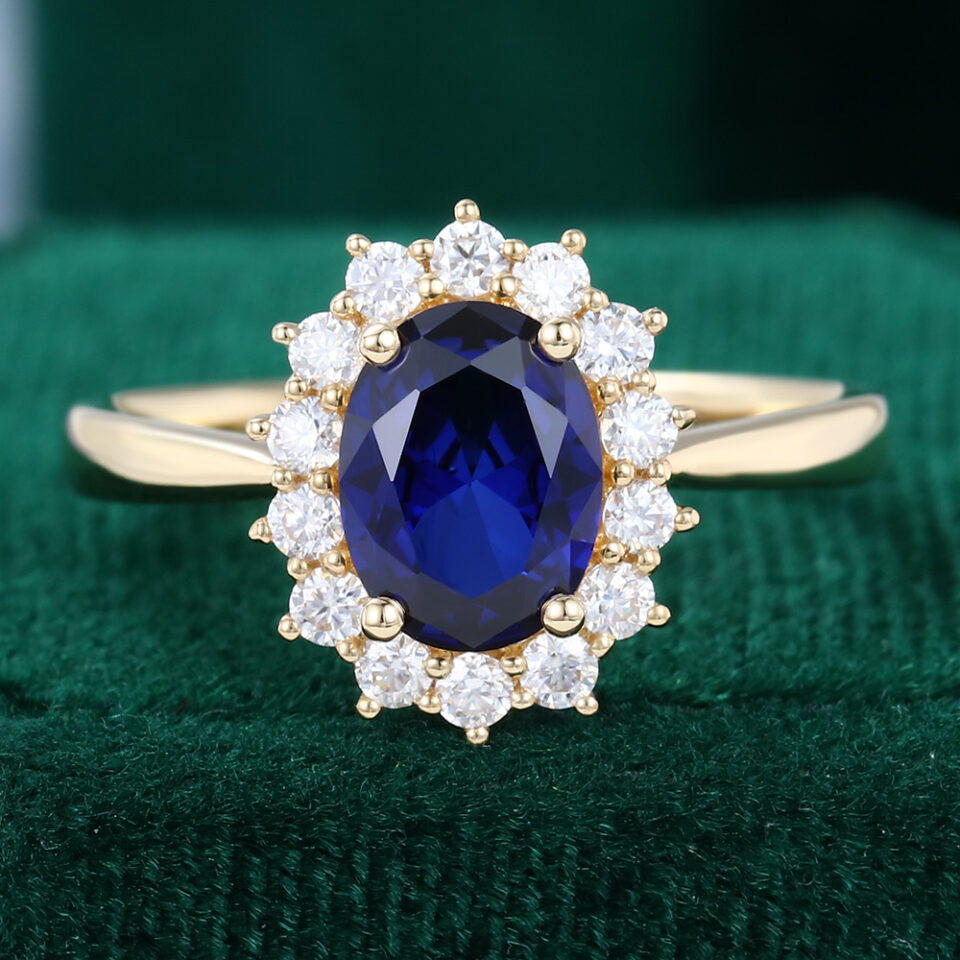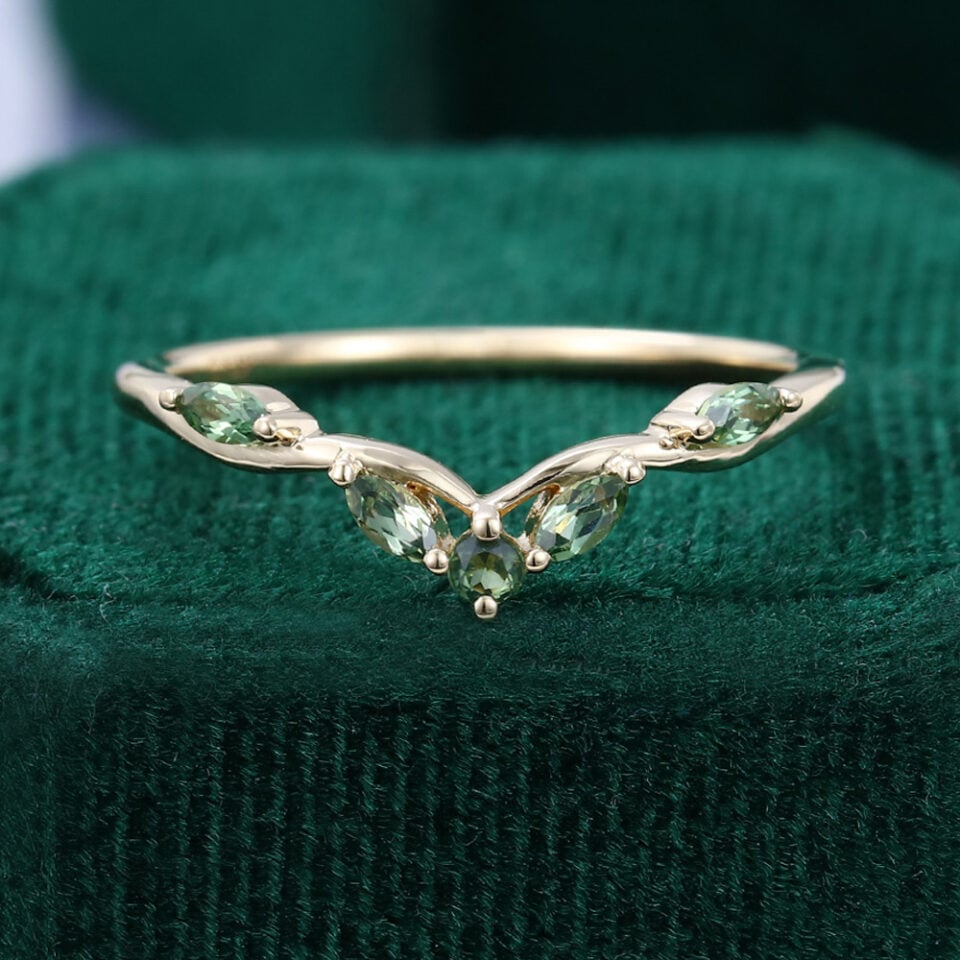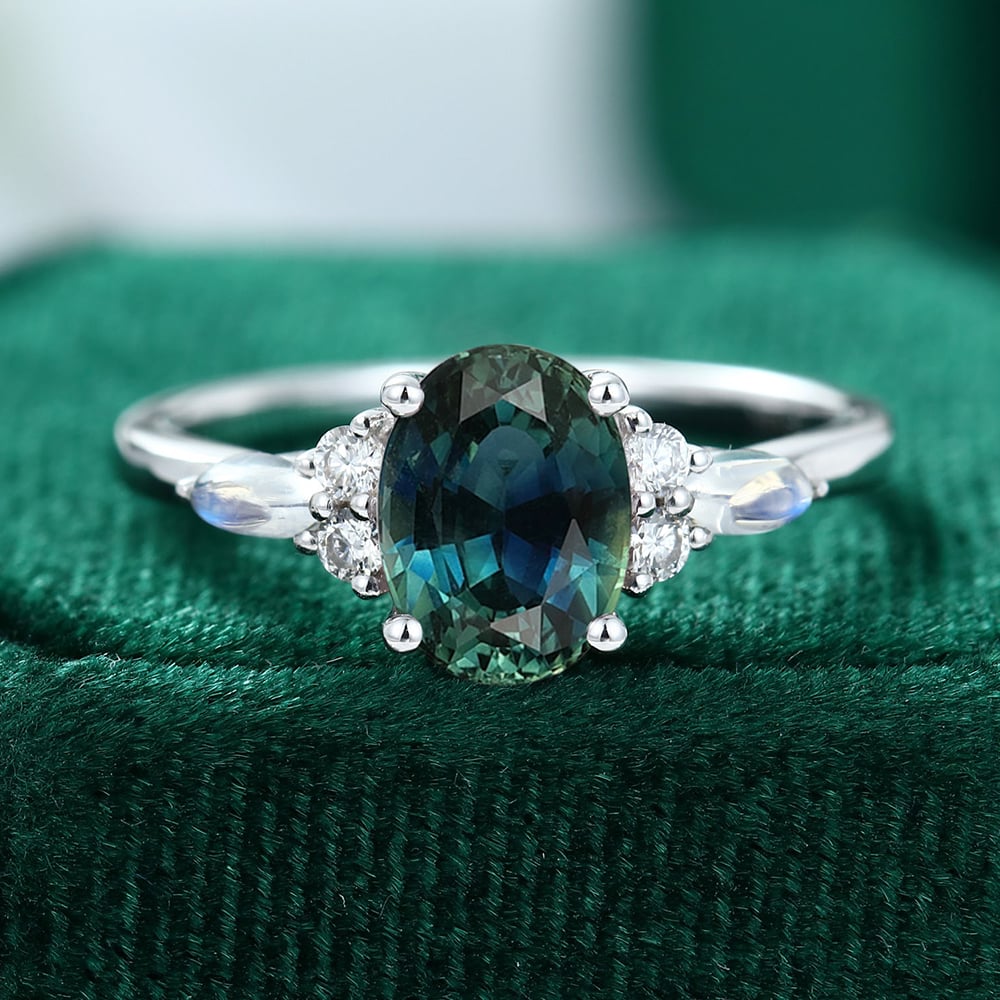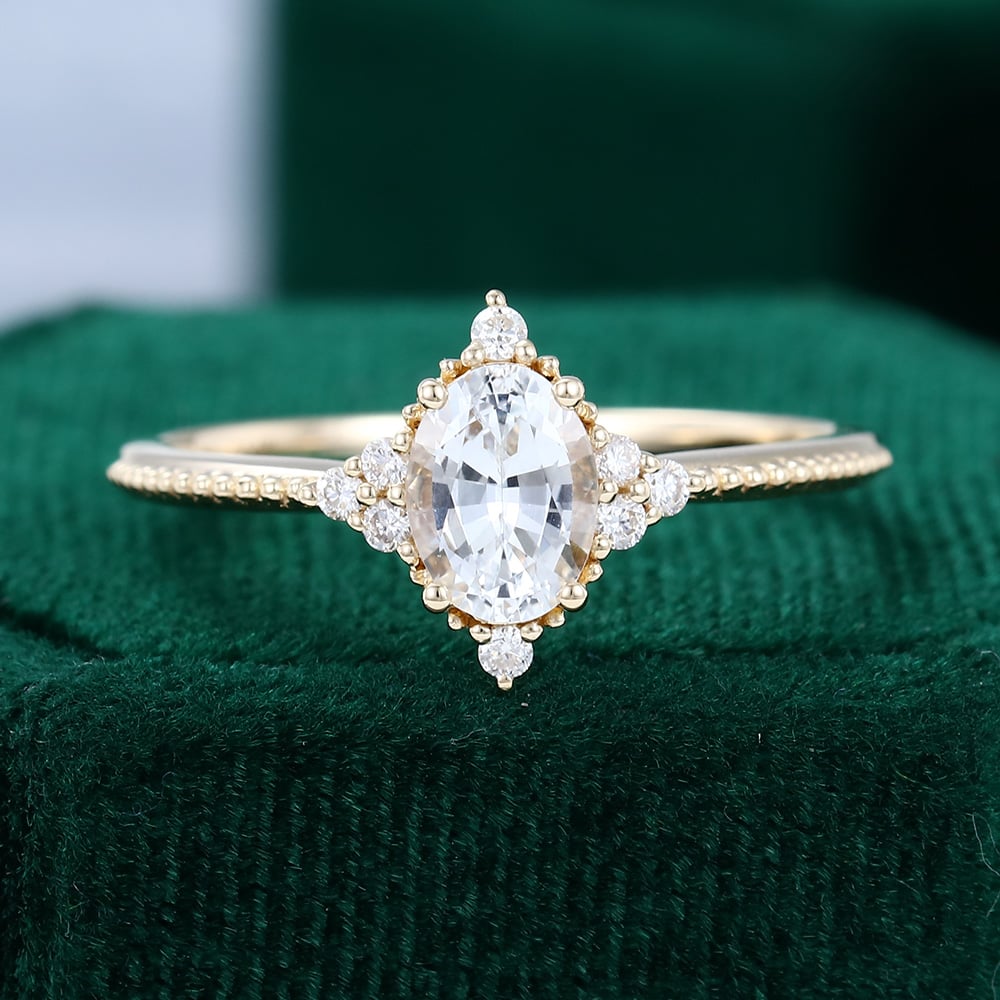Sapphire is a precious gemstone that belongs to the corundum mineral family. With a Mohs hardness of 9, this mineral is highly durable and suitable for everyday wear, Sapphire rings and sapphire pendants are the most popular categories of sapphire jewelry. How many colors of sapphire do you know, 1? 2? In this article, we’ll take an in-depth look at sapphires and bring you up to speed on everything you need to know about this gemstone.

Culture and History of Sapphires
Since ancient times, people have worn sapphires as a sign of strength and protection, dating back to the ancient Greeks and Romans. In the past, people believed that sapphires offered defensive qualities, particularly against poison and evil spirits. For instance, people in the Middle Ages believed that sapphires enhanced their favor with the gods and their precognitive abilities, as well as shielded the wearer from sky-diving calamities.
Sapphires are also a universal sign of grandeur and wisdom. Royalty frequently wore sapphires as jewelry, particularly valuing blue sapphires for their representation of heaven due to their azure hue. Moreover, people often use sapphires to adorn the rings of popes and bishops, as well as other holy items in religious artwork.
Sapphire Colors and Symbolism
Sapphires can be any color other than red, although the name “sapphire” usually conjures up images of blue. The different colors of sapphires are usually influenced by the chemical elements they contain (iron(Fe), titanium(Ti), chromium(Cr), nickel(Ni), copper(Cu), or magnesium(Mg), etc.). Different combinations of these elements produce different colors and different colors of sapphires have different symbolism.
Blue Sapphire
The most common and well-liked kind of sapphire is blue, and the trace levels of iron and titanium are typically responsible for their color. During the sapphire’s crystallization process, these elements partially replace the aluminum atoms, changing the sapphire’s absorption of light and giving it a stunning blue hue, from pale blue to deep blue, like the ocean.
Blue Sapphire Symbolism: The deep blue color of blue sapphire is sometimes compared to the enormous sky or the deep ocean, signifying an endless array of possibilities. Blue sapphire is seen as a symbol of knowledge. Spiritually speaking, blue sapphire is thought to encourage mental openness and clarity, which enables people to remain composed and focused in the face of adversity. It is also frequently given as a gift at wedding anniversaries, particularly the 45th wedding anniversary, and it represents commitment and trust.
Pink Sapphire
The primary pigment source in rubies, chromium, is present in trace amounts in pink sapphires. The quantity of chromium in sapphires is low enough to maintain the stone’s pink hue, but not high enough to produce ruby’s vivid red hue. The color of pink sapphires can vary from pale pink to rich pink.
Pink Sapphire Symbolism: A popular symbol of love and tenderness, pink sapphire radiates a gentle and comforting aura. It is thought to improve harmony and interpersonal connections by encouraging compassion and understanding in the user. Pink sapphire is also linked to the heart chakra, which opens the way to new romantic relationships by assisting in the release of emotional trauma and tensions.
Orange Sapphire (Padparadscha)
The combination of trace amounts of iron and chromium is the primary source of orange sapphires, also called “Padparadscha sapphires”. This sapphire’s orange hue can vary from a soft orange to a striking sunset orange.
Orange Sapphire Symbolism: Orange sapphire is a rare diamond that represents creativity and originality. Its color seems to capture the final rays of the setting sun. Orange sapphire is regarded as a stone that stimulates fresh thinking and viewpoints in artistic domains. Its vibrancy encourages communication and sociability, which helps people adjust to life’s changes with a more upbeat outlook.
Yellow Sapphire
Iron content is greater in yellow sapphires. Because of the particular valence state of iron, sapphire absorbs a portion of the spectrum, giving the reflected light a yellow appearance. The color of yellow sapphires can vary from pale yellow to golden yellow.
Yellow Sapphire Symbolism: Bright and vivid as sunshine, yellow sapphire is a sign of prosperity and hope. It is thought to enhance self-confidence and decision-making abilities while drawing riches and success. Additionally linked to the third eye chakra, yellow sapphire improves intuition and makes it easier for people to perceive where their lives are headed.
Green Sapphire
The conventional process for creating green sapphire involves combining particular iron and titanium components, which can take on a green hue when these two components are present in varying amounts.
Green Sapphire Symbolism: Green sapphire is strongly linked to the tenacity and vigor of the natural world. Sapphires with this color are said to assist people to regain mental and physical equilibrium as well as increase their awareness of their environment. Additionally, it represents growth and fresh starts, particularly for anyone going through a life transition.
Purple Sapphire
Purple sapphires can contain traces of iron and chromium. The purple hue of sapphires, which varies from light to deep purple, is the result of iron and chromium working together.
Purple Sapphire Symbolism: Purple sapphire is a deep, enigmatic stone that stands for wisdom and spiritual development. It is said that sapphires of this color foster deeper spiritual connections and inner awareness. Purple sapphires are frequently utilized to aid in the exploration of higher truths outside of the physical world during meditation and other spiritual pursuits.
Colorless Sapphire
Colorless sapphire, also known as white sapphire, is essentially pure aluminum oxide, devoid of any contaminants that could impart color. They can occasionally be used in place of diamonds because they are totally transparent.
Colorless Sapphire Symbolism: Colorless sapphire also known as white sapphire, it’s so pure, colorless, or clear, that it is considered a symbol of honesty and truth. Similar to a mirror, it shows the wearer’s actual self, inspiring individuals to express themselves authentically.
Gray Sapphire
Because gray sapphire has a higher iron content, the iron’s presence affects how light is reflected and absorbed, giving the stone a gray appearance.
Gray Sapphire Symbolism: Gray Sapphire helps people maintain their composure amid uncertainty and change by symbolizing neutrality balance, stability, and patience. Those who want to achieve mental serenity amid a hectic and complicated existence can benefit from this sapphire color.
Brown Sapphire
The concentration of iron in brown sapphires is higher than that of gray or yellow sapphires, or occasionally a particular mix of titanium and iron gives the stone its brown hue.
Brown Sapphire Symbolism: Brown sapphire is intimately associated with the ground and represents steadiness, endurance, and common sense. It is a stabilizing and supporting stone that offers protection, enabling one to maintain composure in the face of adversity.
Black Sapphire
TiO and iron concentrations in black sapphire are incredibly high. The stone’s rich dark hue is a result of these components’ strong absorption of light.
Black Sapphire Symbolism: Black sapphire stands for the strongest defense and fortitude. It is thought to give the wearer a mental shield, shielding them from psychological assaults and harmful outside influences. Black sapphire is also linked to profound self-transformation and discovery, assisting individuals in realizing their inner potential and latent abilities.
Every sapphire hue has a distinct charm and market of its own. Customers can take into account personal color preferences and uniqueness in addition to the color’s aesthetic appeal while selecting.
Sapphire Optical Characteristics Types
One can categorize sapphires not only by color but also by internal characteristics, including optical effects and structural characteristics. Star and cat’s eye sapphires are the most well-known of these unique varieties. Most often, the structure and placement of inclusions within the gemstone are responsible for the appearance of these interesting effects.
Star Sapphire
Star sapphire is a type of sapphire that exhibits a “starlight” effect, meaning that light shining on it produces a dazzling, star-like light display. Light scattering in sapphire is created by microscopic needle-like inclusions (often rutile crystals) within the material. To form a six-spoke star design that meets at one point, the inclusions must be placed in a precise arrangement, typically in three parallel groups at 60-degree angles to one another. While the starlight effect can appear in sapphires of all hues, blue and black sapphires are the most likely to exhibit it. Star sapphires frequently need a certain cut, like a cabochon, in order to enhance the visible star impact
Cat Eye Sapphire
The “cat’s eye effect” is a rare optical phenomenon that causes a bright, narrow strip of light to seem like a cat’s eye on the surface of the gemstone, as demonstrated by the cat’s eye sapphires. Inside the gemstone, tiny, parallel-arranged needle-like or fibrous inclusions create the look known academically as the “light effect.” These structures produce a dynamic visual effect when light strikes them from a certain angle, concentrating on a narrow strip. A dome-shaped incision is another common enhancement for the cat’s-eye effect, guaranteeing that the observer perceives a distinct band of light from various perspectives.
Color Change Sapphire
You wouldn’t imagine that there are color-changing sapphires, as they are scarce and many people only believe they exist once they see them in person. Color-changing sapphires are interesting in that they may appear in different colors under different light sources, or at different angles under the same light source. These color-changing sapphires are mainly found in Sri Lanka and Tanzania, but they are really rare and their production is so small that the public rarely sees them, so it’s no wonder that many people don’t believe in their existence.
Multicolored sapphires
Some people will confuse the multicolored sapphire with the color change sapphire, thinking that they are the same, but, not, multicolored sapphire in the same environment under the same perspective still presents different colors, this color span is usually not very large, but only the same color shade of brightness shades of change, for example, from the light blue to the dark blue change. This type may be rather different from the uniformity of gemstone color that many people seek, but it still presents this unique effect that is sought after by many.
Starlight and Cat’s Eye Sapphire Reviews
The clarity, symmetry, and beauty of the stars or light bands frequently determine the value of star and cat’s eye sapphires. Generally speaking, a more prominent and symmetrical cat-eye or starburst effect is more expensive and appealing. A gemstone’s color, clarity, and general quality are other crucial considerations for determining its total worth.
In addition to their beauty and distinctiveness, star sapphires and cat’s eye sapphires are highly sought-after in the gemstone industry due to their special optical effects. They also have great cultural and historical significance. In addition to being a favorite among jewelry collectors, gem aficionados and experts also examine them.
Sapphire Applications
Sapphires are prized for their beauty and rarity, but their hardness and endurance also make them brilliant in a wide range of applications. These are a handful of Sapphire’s primary applications:
Jewels
Sapphires are most often and traditionally used in jewelry production. Sapphire’s great physical characteristics and gorgeous color make it a popular material for making jewelry such as bracelets, necklaces, earrings, and rings. Sapphire is a highly durable gemstone (9 on the Mohs scale), making it perfect for everyday use. Furthermore, sapphires come in a variety of colors that provide endless design possibilities, which is why high-end and custom jewelry designs love to use them.
Collection
Collectors value sapphires because of their uncommon hues and remarkable inherent characteristics, like color-changing and star sapphires. Premium sapphire stones can be preserved in their unprocessed state, showcasing their inherent color and crystal structure, or maintained separately as collections. Additionally, high-end collectors particularly go after sapphires in uncommon hues like orange and pink.
Purchasing and Care of Sapphire Tips
To guarantee that the stone you invest in is stunning, durable, and maintains its worth, sapphires require certain knowledge and abilities during the purchasing and maintenance processes.
How to Choose Sapphire?
- Recognize the Source and Quality: Understanding a sapphire’s origin is crucial when selecting one, as sapphires from various locations may differ in terms of color and value. Verifying if the stone is in its natural state or has undergone any treatment—such as heating or filling—is also crucial.
- Examine the Color and Transparency of the Sapphire: One of the most crucial aspects of a sapphire’s quality is its color. The hue of sapphire of superior quality should be bright and consistent. Another crucial factor to take into account is transparency, as very transparent gemstones typically fetch higher prices.
- Think About the Stone’s Form and Cut: The cut greatly affects the stone’s overall brightness and look. A well-cut stone can enhance a gemstone’s brilliance and color, giving it a more vibrant and appealing appearance.
Tips for Care of Sapphire
- Routine Cleaning: Use warm water and mild soap to clean your sapphire. Then, carefully scrub the gemstone with a soft-bristled brush to remove any accumulated dirt or oil.
- Steer Clear of Powerful Hits: Despite sapphire’s extreme hardness, forceful impacts can cause it to scratch or break. It is advisable to take it off prior to physical exertion or in circumstances where the stone could be harmed.
- Steer Clear of Severe Temperatures and Chemicals: Extended exposure to either of these can harm the structure and shine of sapphire. When wearing and storing, one should take care to avoid such conditions.
Conclusion
Sapphire, a gemstone valued for its beauty and rarity in the jewelry industry, also finds utility in business and technology. Whether as high-tech materials, jewelry, or souvenirs, sapphires exhibit their distinct significance and diversity. With the correct purchasing approach and maintenance, these priceless diamonds can maintain their distinctive beauty and worth for many years to come. Knowing the many kinds, applications, and maintenance advice for sapphire is essential before making an investment. This will enable you to completely appreciate all that this gemstone has to offer and make an informed decision.









